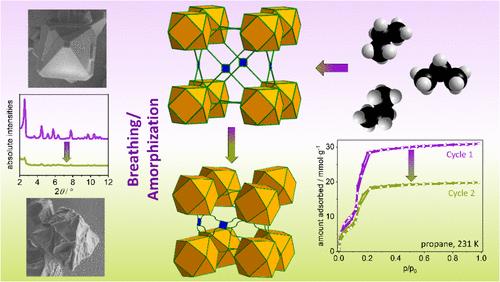用烃类物理吸附法探讨介孔金属-有机骨架DUT-76(Cu)的机械稳定性极限
IF 8.2
2区 材料科学
Q1 MATERIALS SCIENCE, MULTIDISCIPLINARY
引用次数: 0
摘要
mof的机械稳健性在大多数吸附相关应用中是至关重要的。本文研究了介孔金属-有机骨架DUT-76(Cu)与多种C1-C4碳氢化合物在沸点下的相互作用。在吸附过程中,孔隙结构部分坍塌成无定形相,同时保留了残余孔隙度。我们使用不同碳氢化合物(甲烷、乙烷、乙烯、丙烷、丙烯、正丁烷和1,3-丁二烯)进行多循环物理吸附实验,并使用x射线衍射、扫描电子显微镜和总散射来检查这种转变。这种方法使我们能够全面了解对材料的晶体结构、局部结构和宏观行为的影响。此外,我们还发现了链长、双键数和吸附/解吸循环稳定性之间的特定相关性,这些相关性受到吸附诱导应力的影响。这些多循环吸附实验是评估介孔框架的机械稳定性的半定量工具。本文章由计算机程序翻译,如有差异,请以英文原文为准。

Probing the Limits of Mechanical Stability of the Mesoporous Metal–Organic Framework DUT-76(Cu) by Hydrocarbon Physisorption
The mechanical robustness of MOFs is crucial in most adsorption-related applications. Herein, we investigated the interaction of the mesoporous metal–organic framework DUT-76(Cu) with various C1–C4 hydrocarbons at their boiling points. During adsorption, the pore structure partially collapsed into an amorphous phase while retaining a residual porosity. We employed a combination of multicycle physisorption experiments using different hydrocarbons (methane, ethane, ethylene, propane, propylene, n-butane, and 1,3-butadiene) along with X-ray diffraction, scanning electron microscopy, and total scattering to examine this transition. This methodology allowed us to gain a comprehensive understanding of the effects on the crystal structure, local structure, and macroscopic behavior of the material. Furthermore, we identified specific correlations among the chain length, number of double bonds, and adsorption/desorption cycle stability, which are influenced by adsorption-induced stress. These multicycle adsorption experiments served as semiquantitative tools for assessing the mechanical stability of mesoporous frameworks.
求助全文
通过发布文献求助,成功后即可免费获取论文全文。
去求助
来源期刊

ACS Applied Materials & Interfaces
工程技术-材料科学:综合
CiteScore
16.00
自引率
6.30%
发文量
4978
审稿时长
1.8 months
期刊介绍:
ACS Applied Materials & Interfaces is a leading interdisciplinary journal that brings together chemists, engineers, physicists, and biologists to explore the development and utilization of newly-discovered materials and interfacial processes for specific applications. Our journal has experienced remarkable growth since its establishment in 2009, both in terms of the number of articles published and the impact of the research showcased. We are proud to foster a truly global community, with the majority of published articles originating from outside the United States, reflecting the rapid growth of applied research worldwide.
 求助内容:
求助内容: 应助结果提醒方式:
应助结果提醒方式:


